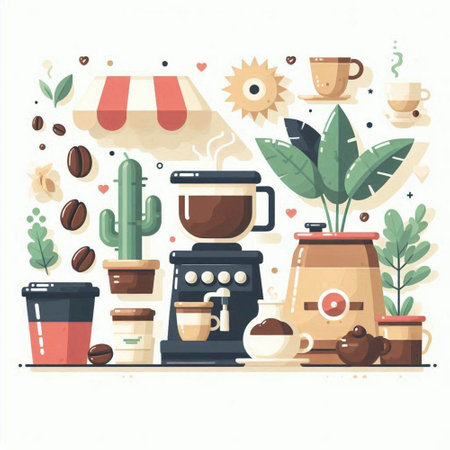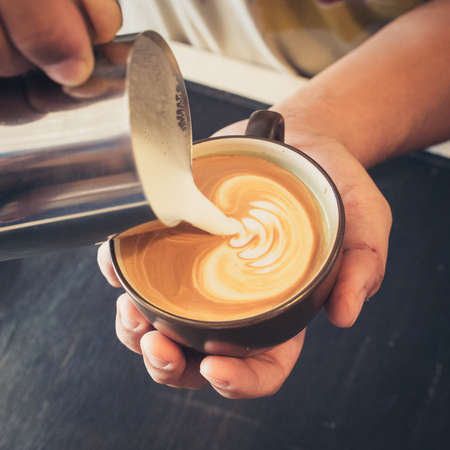Introduction: Bringing the Coffeehouse Home
Across America, the aroma of freshly brewed coffee is as much a part of daily life as morning traffic or the hum of city streets. In recent years, our collective love affair with specialty coffee—those perfectly crafted lattes and frothy cappuccinos—has stepped beyond the cozy corners of local cafés and right into our kitchens. This shift isn’t just about convenience or saving a few dollars (though that’s a definite perk). For many, making café-quality drinks at home has become a satisfying ritual, an expression of creativity, and a way to savor a moment of calm in an always-on world. As more folks look for affordable ways to enjoy their favorite espresso drinks without leaving home, it’s clear: the home barista trend is here to stay, blending the comforts of home with the flavors we crave from our favorite coffee shops.
2. Must-Have Affordable Equipment
If you’re dreaming of crafting that perfect latte or cappuccino at home, but don’t want to empty your wallet, you’re in luck—there’s a treasure trove of budget-friendly equipment available across the U.S. market. Here’s an overview of the essential tools every aspiring home barista needs, plus some smart, affordable picks that strike a balance between quality and value.
Espresso Machines: Entry-Level Picks
The heart of any good latte or cappuccino is a solid espresso shot. You don’t need a thousand-dollar machine for café-quality results—many American brands offer reliable entry-level models that get the job done without fuss. Look for options with consistent pressure (at least 9 bars) and user-friendly controls.
| Model | Approx. Price | Main Features |
|---|---|---|
| DeLonghi EC155 | $120 | Compact, manual frother, easy to clean |
| Mr. Coffee Café Barista | $200 | Semi-automatic, one-touch control panel, integrated milk frother |
| Nespresso Essenza Mini | $150 | Pod-based, compact, quick heating |
Milk Frothers: Creamy Foam on a Budget
No latte or cappuccino is complete without velvety microfoam. While pricier machines include steam wands, there are plenty of standalone frothers that deliver great results—whether you prefer handheld or electric versions.
| Model | Approx. Price | Main Features |
|---|---|---|
| Zulay MilkBoss Handheld Frother | $15 | Cordless, portable, easy to use and clean |
| Bodum Bistro Electric Frother | $30 | Automatic, stainless steel pitcher, compact design |
| Aerolatte Original Milk Frother | $20 | Battery operated, lightweight, durable whisk head |
Coffee Grinders: Freshness Matters
Nothing beats grinding your own beans for maximum flavor. Burr grinders are preferred by enthusiasts for their even grind size and better extraction. Here are some wallet-friendly choices found in most American stores:
| Model | Approx. Price | Main Features |
|---|---|---|
| Hamilton Beach Fresh Grind 4.5oz Electric Grinder | $20 | Quiet motor, removable chamber, simple operation |
| Bodum Bistro Burr Grinder | $70-$100 | Burr system, adjustable grind settings, colorful design options |
| Krups Precision Grinder GX5000 | $45 | 12 grind settings, large capacity, easy cleaning |
Tasteful Brewing Without Breaking the Bank
The American market offers an impressive range of affordable tools for creating coffeehouse-worthy drinks at home. Whether you’re just starting out or upgrading your setup, these entry-level espresso machines, milk frothers, and grinders make it easy to savor every sip—without blowing your budget.

3. Best Budget Espresso Machines
If you’re determined to brew café-style lattes or cappuccinos at home without emptying your wallet, you’ll want to focus on entry-level espresso machines that are both affordable and reliable. In the US, there’s a solid selection of espresso machines under $200, available at big-box retailers like Target or Walmart, as well as online through Amazon and specialty coffee sites. These budget-friendly options might not have all the bells and whistles of high-end models, but they can deliver surprisingly good results for beginners and casual home baristas.
Spotlight on Popular Models
Some of the most popular picks in this price range include the De’Longhi EC155, Mr. Coffee Café Barista, and Nespresso Essenza Mini. The De’Longhi EC155 is a long-standing favorite for its compact size and consistent espresso shots; it features a manual frother that lets you practice your milk steaming skills. Mr. Coffee’s Café Barista is an all-in-one semi-automatic machine with a built-in milk frother—perfect for those who want convenience without sacrificing quality. For fans of simplicity, the Nespresso Essenza Mini uses pods to create espresso quickly with minimal mess and effort.
Pros: Accessibility and Simplicity
The biggest advantage of these machines is accessibility—they’re easy to find, easy to use, and won’t intimidate first-time users. Many come with straightforward controls and clear instructions, so you can go from unboxing to brewing in less than 30 minutes. Their small footprints also make them ideal for apartments or kitchens with limited counter space.
Cons: Limitations and Compromises
On the flip side, entry-level machines do come with some trade-offs. You may notice slightly lower pressure compared to premium models, which can affect crema quality or flavor extraction. Steam wands may be less powerful or offer less control over milk texture—something to consider if latte art is high on your wishlist. Additionally, build quality and longevity may not match more expensive brands; regular maintenance is key to keeping these machines running smoothly.
Real-World Recommendations
If you’re just starting out or want an affordable way to experiment with homemade espresso drinks, these budget machines are a fantastic entry point. Pair one with freshly ground beans (even if you start with pre-ground), invest in a simple milk frothing pitcher, and embrace the learning curve. As your skills grow, you’ll get a feel for what features matter most—making it easier to decide if upgrading down the road is worth it for your morning ritual.
4. Milk Frothing Solutions on a Shoestring
Let’s face it: the secret to any café-worthy latte or cappuccino is that rich, velvety microfoam. But you don’t have to drop big bucks on a commercial-grade steamer to make it happen at home. In fact, with a little American ingenuity and the right budget-friendly tools, anyone can nail the perfect froth—whether you’re prepping for your morning rush or hosting a weekend brunch. Here’s a quick comparison of affordable milk frothing options that easily fit into any U.S. kitchen:
| Frothing Method | Average Price Range | Pros | Cons |
|---|---|---|---|
| Handheld Electric Frother | $10–$20 | Fast, easy to clean, compact storage | Batteries required, not ideal for large batches |
| Manual Pump Frother (e.g., French press style) | $15–$30 | No electricity needed, doubles as coffee press, consistent foam | Takes more effort, glass models can be fragile |
| Mason Jar Hack | $0 (if you already own one) | Super cheap, no extra gear needed, fun DIY vibe | Foam less silky, heat by microwaving (watch for hot spots) |
| Stovetop Wand Steamer Attachment | $25–$40 | Mimics café results, works with gas/electric ranges, durable build | Larger footprint, learning curve to master steam technique |
Each method has its quirks, but all deliver creamy foam without draining your wallet. The trusty handheld frother is perfect if you want quick results before heading out on your daily commute—just whip up your milk in 30 seconds and rinse it off. For those who appreciate a hands-on ritual (and maybe want to flex those biceps), the manual pump frother channels old-school charm and consistency. And if you love a good hack, shaking warm milk in a mason jar is practically free and adds a little fun to your morning routine (just remember to use a towel when grabbing that hot glass). If you’re aiming for something close to what your local barista pulls off, investing in a stovetop wand can take your skills up a notch while still keeping things affordable.
5. Coffee Grinders that Won’t Break the Bank
If you’re serious about crafting that café-quality latte or cappuccino at home, investing in a reliable coffee grinder is non-negotiable. But before you get sticker shock at high-end models, let’s break down the two main types you’ll see in American kitchens: burr grinders and blade grinders.
Burr vs. Blade: What’s the Difference?
Burr grinders use two revolving abrasive surfaces (the burrs) to grind beans consistently, resulting in uniform coffee grounds—crucial for espresso shots and silky microfoam milk drinks. Meanwhile, blade grinders chop beans with spinning blades, which can lead to uneven particle sizes and unpredictable results. For home baristas aiming for that perfect latte, burr grinders tend to be the gold standard, but they’re often pricier.
Which Should You Choose?
If you’re just starting out or watching your wallet, a quality blade grinder can still do the trick for daily brewing—just shake it as you grind for a more even result. However, if you want to level up your game and get consistent espresso shots for your homemade cappuccino, a budget-friendly burr grinder is well worth the extra investment.
Top Budget Picks on the U.S. Market
For those ready to shop stateside, here are some affordable, highly-rated options:
- Krups Precision Grinder: A compact burr grinder under $50, perfect for small apartments and beginner brewers.
- Cuisinart DBM-8 Supreme Grind: A crowd favorite in American households, this entry-level burr grinder consistently delivers great results for under $70.
- Hamilton Beach Fresh Grind: If you’re sticking with blades, this model is under $20 and gets the job done for casual lattes.
The right grinder doesn’t have to eat up your coffee budget. With these options, your journey to barista-level lattes and cappuccinos at home stays deliciously affordable.
6. Tips for Crafting Your Café Favorites at Home
Brewing a swoon-worthy latte or cappuccino in your own kitchen doesn’t mean splurging on high-end machines. Armed with affordable gear and a few practical techniques, you can turn your countertop into your favorite neighborhood coffee spot—without the barista price tag.
Start With Solid Basics
For espresso, consistency is key. Even if you’re working with an entry-level machine, make sure your grind is fine and uniform—investing in a quality burr grinder pays off big time, even on a budget. Tamp evenly and use fresh beans for that rich crema we all crave.
Milk Texturing Made Easy
No fancy steam wand? No problem! Use a handheld milk frother or even shake warmed milk in a mason jar to create microfoam. Heat your milk to about 150°F (65°C)—that’s hot to the touch but not scalding—to get that silky-smooth texture perfect for lattes and cappuccinos alike.
Nail the Pour
Pour your espresso shot first, then add your milk slowly from a little height to blend, finishing with a gentle wiggle of the wrist for simple latte art. Practice hearts or leaves—Instagram loves them, and so will your morning routine!
Keep It Clean & Dialed In
A quick rinse of your equipment after every use keeps flavors fresh and shots tasting true. Experiment with different beans and milks—oat, almond, or classic whole milk—to find your personal café-style favorite without leaving home.
With these budget-friendly tips and tools, youll be brewing Insta-worthy drinks in your American kitchen—proving great coffee isn’t just for coffee shops or big spenders.
7. Conclusion: Savor the Coffeehouse Vibes Anywhere
There’s something unmistakably American about rolling up your sleeves and crafting your own perfect cup of coffee—right in the comfort of your home. With affordable, reliable equipment, brewing a creamy latte or foamy cappuccino isn’t just a weekend treat but an everyday ritual that brings a touch of café magic to your kitchen. As you tinker with your espresso machine, frother, or even a classic moka pot, each step becomes an invitation to slow down and enjoy the simple pleasures. So, channel your inner barista, experiment with flavors, and let the aroma of fresh coffee turn your space into your favorite local hangout. Embrace the DIY spirit, create cozy moments, and remember: with the right tools and a dash of creativity, every day can feel like a coffeehouse adventure—no matter where you are.


